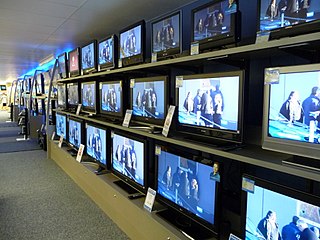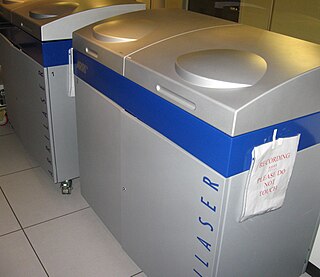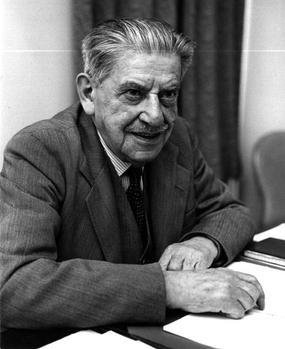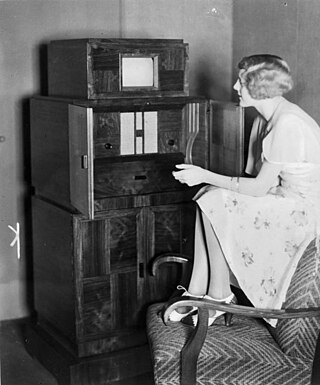
Television (TV) is a telecommunication medium for transmitting moving images and sound. The term can refer to a television set, or the medium of television transmission. Television is a mass medium for advertising, entertainment, news, and sports.

John Logie BairdFRSE was a Scottish inventor, electrical engineer, and innovator who demonstrated the world's first live working television system on 26 January 1926. He went on to invent the first publicly demonstrated colour television system and the first viable purely electronic colour television picture tube.

Kinescope, shortened to kine, also known as telerecording in Britain, is a recording of a television program on motion picture film, directly through a lens focused on the screen of a video monitor. The process was pioneered during the 1940s for the preservation, re-broadcasting and sale of television programmes before the introduction of quadruplex videotape, which from 1956 eventually superseded the use of kinescopes for all of these purposes. Kinescopes were the only practical way to preserve live television broadcasts prior to videotape.

Telecine is the process of transferring film into video and is performed in a color suite. The term is also used to refer to the equipment used in the post-production process. Telecine enables a motion picture, captured originally on film stock, to be viewed with standard video equipment, such as television sets, video cassette recorders (VCR), DVD, Blu-ray Disc or computers. Initially, this allowed television broadcasters to produce programs using film, usually 16-mm stock, but transmit them in the same format, and quality, as other forms of television production. Furthermore, telecine allows film producers, television producers and film distributors working in the film industry to release their productions on video and allows producers to use video production equipment to complete their filmmaking projects. Within the film industry, it is also referred to as a TK, because TC is already used to designate timecode. Motion picture film scanners are similar to telecines.

A professional video camera is a high-end device for creating electronic moving images. Originally developed for use in television studios or with outside broadcast trucks, they are now also used for music videos, direct-to-video movies, corporate and educational videos, wedding videos, among other uses. Since the 2000s, most professional video cameras are digital professional video cameras.

A film recorder is a graphical output device for transferring images to photographic film from a digital source. In a typical film recorder, an image is passed from a host computer to a mechanism to expose film through a variety of methods, historically by direct photography of a high-resolution cathode ray tube (CRT) display. The exposed film can then be developed using conventional developing techniques, and displayed with a slide or motion picture projector. The use of film recorders predates the current use of digital projectors, which eliminate the time and cost involved in the intermediate step of transferring computer images to film stock, instead directly displaying the image signal from a computer. Motion picture film scanners are the opposite of film recorders, copying content from film stock to a computer system. Film recorders can be thought of as modern versions of Kinescopes.

Mechanical television or mechanical scan television is an obsolete television system that relies on a mechanical scanning device, such as a rotating disk with holes in it or a rotating mirror drum, to scan the scene and generate the video signal, and a similar mechanical device at the receiver to display the picture. This contrasts with vacuum tube electronic television technology, using electron beam scanning methods, for example in cathode ray tube (CRT) televisions. Subsequently, modern solid-state liquid-crystal displays (LCD) are now used to create and display television pictures.

1–inch type B VTR is a reel-to-reel analog recording video tape format developed by the Bosch Fernseh division of Bosch in Germany in 1976. The magnetic tape format became the broadcasting standard in continental Europe, but adoption was limited in the United States and United Kingdom, where the Type C videotape VTR met with greater success.

A motion picture film scanner is a device used in digital filmmaking to scan original film for storage as high-resolution digital intermediate files.

A flying-spot scanner (FSS) uses a scanning source of a spot of light, such as a high-resolution, high-light-output, low-persistence cathode ray tube (CRT), to scan an image. Usually the image to be scanned is on photographic film, such as motion picture film, or a slide or photographic plate. The output of the scanner is usually a television signal.

Sir Isaac Shoenberg was a British electronic engineer born in Belarus who was best known for his role in the history of television. He was the head of the EMI research team that developed the 405-line, the first fully electronic television system to be used in regular broadcasting when it was introduced with the BBC Television Service in 1936. It was later adopted by other TV organizations around the world.

The concept of television is the work of many individuals in the late 19th and early 20th centuries. The first practical transmissions of moving images over a radio system used mechanical rotating perforated disks to scan a scene into a time-varying signal that could be reconstructed at a receiver back into an approximation of the original image. Development of television was interrupted by the Second World War. After the end of the war, all-electronic methods of scanning and displaying images became standard. Several different standards for addition of color to transmitted images were developed with different regions using technically incompatible signal standards. Television broadcasting expanded rapidly after World War II, becoming an important mass medium for advertising, propaganda, and entertainment.

Cintel was a British digital cinema company founded in 1927 by John Logie Baird and based in Ware, Hertfordshire. The early company was called Cinema Television Ltd. Cinema Television was sold to J Arthur Rank Organization renamed Rank Cintel in 1958. It specialized in the design and manufacture of professional post-production equipment, for transcribing film into video or data formats. It was formerly part of the Rank Organisation. Along with a line of telecines, Rank Cintel made 3 tube RGB color video projectors in the 1960s.
The Fernseh AG television company was registered in Berlin on July 3, 1929, by John Logie Baird, Robert Bosch, Zeiss Ikon and D.S. Loewe as partners. John Baird owned Baird Television Ltd. in London, Zeiss Ikon was a camera company in Dresden, D.S. Loewe owned a company in Berlin and Robert Bosch owned a company, Robert Bosch GmbH, in Stuttgart. with an initial capital of 100,000 Reichsmark. Fernseh AG did research and manufacturing of television equipment.

A film chain or film island is a television – professional video camera with one or more projectors aligned into the photographic lens of the camera. With two or more projectors a system of front-surface mirrors that can pop-up are used in a multiplexer. These mirrors switch different projectors into the camera lens. The camera could be fed live to air for broadcasting through a vision mixer or recorded to a VTR for post-production or later broadcast. In most TV use this has been replaced by a telecine.
A field-sequential color system (FSC) is a color television system in which the primary color information is transmitted in successive images and which relies on the human vision system to fuse the successive images into a color picture. One field-sequential system was developed by Dr. Peter Goldmark for CBS, which was its sole user in commercial broadcasting. It was first demonstrated to the press on September 4, 1940, and first shown to the general public on January 12, 1950. The Federal Communications Commission adopted it on October 11, 1950, as the standard for color television in the United States, but it was later withdrawn.

180-line is an early electronic television system. It was used in Germany after March 22, 1935, using telecine transmission of film, intermediate film system, or cameras using the Nipkow disk. Simultaneously, fully electronic transmissions using cameras based on the iconoscope began on January 15, 1936 with a definition of 375-lines.

Spirit DataCine is a telecine and a motion picture film scanner. This device is able to transfer 16mm and 35mm motion picture film to NTSC or PAL television standards or one of many High-definition television standards. With the data transfer option a Spirit DataCine can output DPX data files. The image pick up device is a solid state charge-coupled device. This eliminated the need for glass vacuum tube CRTs used on older telecines. The units can transfer negative film, primetime, intermediate film and print film, stock. One option is a Super 8 gate for the transfer of Super 8 mm film. With a sound pick up option, optical 16mm and 35mm sound can be reproduced, also 16mm magnetic strip sound. The unit can operate stand alone or be controlled by a scene by scene color corrector. Ken Burns created The Civil War, a short documentary film included in the DVD release, on how he used the Spirit DataCine to transfer and remaster this film. The operator of the unit is called a Colorist or Colorist Assistant. The Spirit DataCine has become the standard for high-end real-time film transfer and scanning. Over 370 units are used in post-production facilities around the world. Most current film productions are transferred on Spirit DataCines for Television, Digital television, Cable television, Satellite television, Direct-to-video, DVD, Blu-ray Disc, pay-per-view, In-flight entertainment, Stock footage, Dailies, Film preservation, digital intermediate and digital cinema. The Spirit DataCine is made by DFT Digital Film Technology GmbH in Darmstadt, Germany.
The following timeline tables list the discoveries and inventions in the history of electrical and electronic engineering.
The first scheduled, high-definition television programmes were broadcast on 2 November 1936 by the British Broadcasting Corporation. They had been preceded by a number of low-definition BBC test broadcasts, as well as a 180-line Deutscher Fernseh Rundfunk service, from Berlin, since March 1935.














